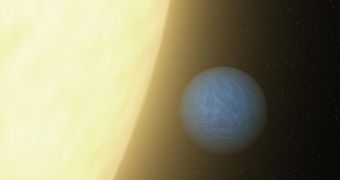In a discovery that opens the way for infrared observatories to conduct exoplanetary studies, the NASA Spitzer Space Telescope has recently identified a super-Earth-class extrasolar planet around the bright star 55 Cancri. This world is uninhabitable, astronomers say.
The object is called 55 Cancri e, and is around two times larger and 8 times heavier than our planet. It orbits its binary star at a distance of around 41 light-years from Earth, in the constellation of Cancer.
Though Spitzer has nowhere near the capabilities of dedicated planet-hunting telescopes, such as the NASA Kepler, it can conduct a series of studies on the atmospheres of distant worlds. This type of study is of extreme importance for upcoming missions, such as the James Webb Space Telescope (JWST).
In the new study, investigators established that the Sun-facing side of 55 Cancri e is heated to around 2,000 degrees Kelvin (3,140ºF, 1,727ºC), whereas its dark side is much cooler. The planet is most likely tidally locked to its parent star, since it only takes 18 hours to complete a full orbit.
This exoplanet is cataloged as a super-Earth because it is larger than our planet, bur smaller than ice giants such as Neptune, or gas giants like Saturn. Spitzer determined that 55 Cancri e is orbiting its parent star a lot closer than Mercury is orbiting the Sun.
“Spitzer has amazed us yet again. The spacecraft is pioneering the study of atmospheres of distant planets and paving the way for NASA's upcoming James Webb Space Telescope to apply a similar technique on potentially habitable planets,” Bill Danchi explains.
The expert holds an appointment as a Spitzer program scientist at NASA Headquarters, in Washington DC. He explains that temperatures on the surface of the exoplanet are hot enough to melt metal.
Spitzer also confirmed that the world is covered in water, just like Neptune. However, the chemical is not in liquid form, but rather in a supercritical state. This means that it's both liquid and gas at the same time. Most likely, the upper layers of the atmosphere are covered in a blanket of Steam.
“It could be very similar to Neptune, if you pulled Neptune in toward our sun and watched its atmosphere boil away,” explains the principal investigators on the new study, Michaël Gillon. He is based at the Université de Liège in Belgium.
Details of the new study were published in the latest issue of the esteemed Astrophysical Journal. Expert Brice-Olivier Demory, from the Cambridge-based Massachusetts Institute of Technology (MIT), was the lead author of the paper.
“When we conceived of Spitzer more than 40 years ago, exoplanets hadn't even been discovered. Because Spitzer was built very well, it's been able to adapt to this new field and make historic advances such as this,” NASA Jet Propulsion Laboratory Spitzer project scientist, Michael Werner, explains.

 14 DAY TRIAL //
14 DAY TRIAL //